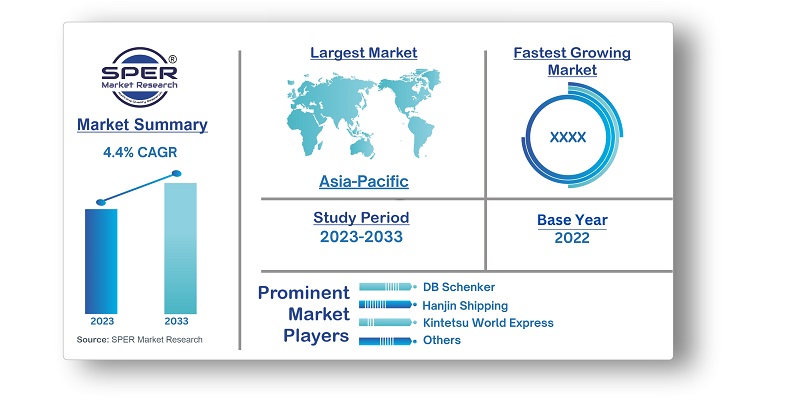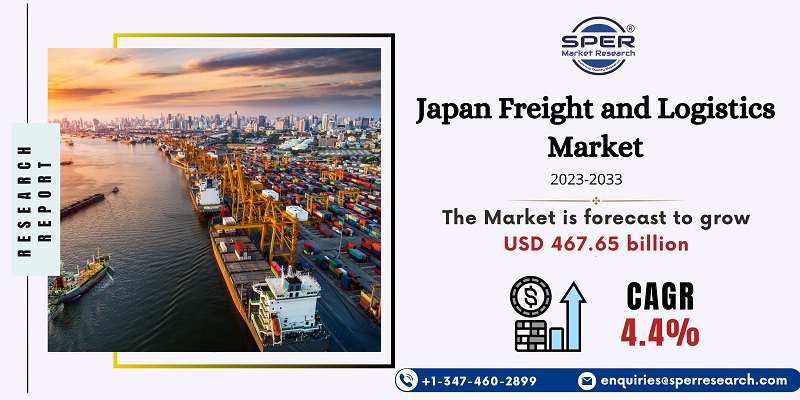
Japan Freight and Logistics Market Growth, Size, Trends, Revenue, Share, Scope and Future Outlook
Japan Freight and Logistics Market Size- By Mode of Transport, By Service Type, By End User- Regional Outlook, Competitive Strategies and Segment Forecast to 2033
| Published: Jan-2024 | Report ID: AMIN2420 | Pages: 1 - 105 | Formats*: |
| Category : Automotive & Transportation | |||
- March 2023: An agreement has been reached between Yamato Transport Co., Ltd. and Colowide MD Co., Ltd., which is responsible for managing merchandising for the Colowide Group. The two businesses will support Colowide Group's supply chain visualisation and optimisation. Colowide Group is the parent company of several brands, including Gyu-Kaku, Kappa Sushi, and OOTOYA.
- November 2022: DHL extended their relationship for a further four years with the German Bobsleigh, Luge, and Skeleton Federation (BSD). A premium and logistical partnership dates back to the winter of 2014–2015. It addresses the branding of sportswear and equipment worn by sportsmen, as well as the seasonal logistics of all equipment.


| Report Metric | Details |
| Market size available for years | 2019-2033 |
| Base year considered | 2022 |
| Forecast period | 2023-2033 |
| Segments covered | By Mode of Transport, By Service Type, By End-User |
| Regions covered | Chubu, Chugoku, Hokkaido, Kansai, Kanto, Kyushu, Okinawa, Shikoku, Tohoku, Others |
| Companies Covered | DB Schenker, Deutsche Post DHL Group, DSV A/S (De Sammensluttede Vognmænd af Air and Sea), Hanjin Shipping, Kintetsu World Express, Kuehne + Nagel, Mitsui O.S.K. Lines, Ltd., Nippon Express, United Parcel Service, Yamato Holdings Co. Ltd, Yusen Logistics, Others |
- E-commerce Companies
- Logistics Service Providers
- Manufacturers and Producers
- Retailers and Distributors
- Supply Chain Managers
- Transportation Companies
- Others
| By Mode of Transport: |
|
| By Service Type: |
|
| By End-User: |
|
- Japan Freight and Logistics Market Size (FY’2023-FY’2033)
- Overview of Japan Freight and Logistics Market
- Segmentation of Japan Freight and Logistics Market By Mode of Transport (Air Freight, Rail Freight, Road Freight, Sea Freight, Others)
- Segmentation of Japan Freight and Logistics Market By Service Type (Courier, Freight Forwarding, Transportation, Warehousing, Others)
- Segmentation of Japan Freight and Logistics Market By End-User (Aerospace & Defense, Automotive, Healthcare, Manufacturing, Retail & Consumer Goods, Others)
- Statistical Snap of Japan Freight and Logistics Market
- Expansion Analysis of Japan Freight and Logistics Market
- Problems and Obstacles in Japan Freight and Logistics Market
- Competitive Landscape in the Japan Freight and Logistics Market
- Impact of COVID-19 and Demonetization on Japan Freight and Logistics Market
- Details on Current Investment in Japan Freight and Logistics Market
- Competitive Analysis of Japan Freight and Logistics Market
- Prominent Players in the Japan Freight and Logistics Market
- SWOT Analysis of Japan Freight and Logistics Market
- Japan Freight and Logistics Market Future Outlook and Projections (FY’2023-FY’2033)
- Recommendations from Analyst
1.1. Scope of the report1.2. Market segment analysis
2.1. Research data source2.1.1. Secondary Data2.1.2. Primary Data2.1.3. SPER’s internal database2.1.4. Premium insight from KOL’s2.2. Market size estimation2.2.1. Top-down and Bottom-up approach
2.3. Data triangulation
4.1. Driver, Restraint, Opportunity and Challenges analysis4.1.1. Drivers4.1.2. Restraints4.1.3. Opportunities4.1.4. Challenges4.2. COVID-19 Impacts of the Japan Freight and Logistics Market
5.1. SWOT Analysis5.1.1. Strengths5.1.2. Weaknesses5.1.3. Opportunities5.1.4. Threats5.2. PESTEL Analysis5.2.1. Political Landscape5.2.2. Economic Landscape5.2.3. Social Landscape5.2.4. Technological Landscape5.2.5. Environmental Landscape5.2.6. Legal Landscape5.3. PORTER’s Five Forces5.3.1. Bargaining power of suppliers5.3.2. Bargaining power of buyers5.3.3. Threat of Substitute5.3.4. Threat of new entrant5.3.5. Competitive rivalry5.4. Heat Map Analysis
6.1. Japan Freight and Logistics Market Manufacturing Base Distribution, Sales Area, Product Type6.2. Mergers & Acquisitions, Partnerships, Product Launch, and Collaboration in Japan Freight and Logistics Market
7.1. Japan Freight and Logistics Market Value Share and Forecast, By Mode of Transport, 2023-20337.2. Air Freight7.3. Rail Freight7.4. Road Freight7.5. Sea Freight7.6. Others
8.1. Japan Freight and Logistics Market Value Share and Forecast, By Service Type, 2023-20338.2. Courier8.3. Freight Forwarding8.4. Transportation8.5. Warehousing8.6. Others
9.1. Japan Freight and Logistics Market Value Share and Forecast, By End-User, 2023-20339.2. Aerospace & Defense9.3. Automotive9.4. Healthcare9.5. Manufacturing9.6. Retail & Consumer Goods9.7. Others
10.1. Japan Freight and Logistics Market Size and Market Share
11.1. Japan Freight and Logistics Market Size and Market Share By Mode of Transport (2019-2026)11.2. Japan Freight and Logistics Market Size and Market Share By Mode of Transport (2027-2033)
12.1. Japan Freight and Logistics Market Size and Market Share By Service Type (2019-2026)12.2. Japan Freight and Logistics Market Size and Market Share By Service Type (2027-2033)
13.1. Japan Freight and Logistics Market Size and Market Share By End-User (2019-2026)13.2. Japan Freight and Logistics Market Size and Market Share By End-User (2027-2033)
14.1. Japan Freight and Logistics Market Size and Market Share By Region (2019-2026)14.2. Japan Freight and Logistics Market Size and Market Share By Region (2027-2033)14.3. Chubu14.4. Chugoku14.5. Hokkaido14.6. Kansai14.7. Kanto14.8. Kyushu14.9. Okinawa14.10. Shikoku14.11. Tohoku14.12. Others
15.1. DB Schenker15.1.1. Company details15.1.2. Financial outlook15.1.3. Product summary15.1.4. Recent developments15.2. Deutsche Post DHL Group15.2.1. Company details15.2.2. Financial outlook15.2.3. Product summary15.2.4. Recent developments15.3. DSV A/S (De Sammensluttede Vognmænd af Air and Sea)15.3.1. Company details15.3.2. Financial outlook15.3.3. Product summary15.3.4. Recent developments15.4. Hanjin Shipping15.4.1. Company details15.4.2. Financial outlook15.4.3. Product summary15.4.4. Recent developments15.5. Kintetsu World Express15.5.1. Company details15.5.2. Financial outlook15.5.3. Product summary15.5.4. Recent developments15.6. Kuehne + Nagel15.6.1. Company details15.6.2. Financial outlook15.6.3. Product summary15.6.4. Recent developments15.7. Mitsui O.S.K. Lines, Ltd.15.7.1. Company details15.7.2. Financial outlook15.7.3. Product summary15.7.4. Recent developments15.8. Nippon Express15.8.1. Company details15.8.2. Financial outlook15.8.3. Product summary15.8.4. Recent developments15.9. United Parcel Service15.9.1. Company details15.9.2. Financial outlook15.9.3. Product summary15.9.4. Recent developments15.10. Yamato Holdings Co. Ltd15.10.1. Company details15.10.2. Financial outlook15.10.3. Product summary15.10.4. Recent developments15.11. Yusen Logistics15.11.1. Company details15.11.2. Financial outlook15.11.3. Product summary15.11.4. Recent developments15.12. V Charge Trading LLC15.12.1. Company details15.12.2. Financial outlook15.12.3. Product summary15.12.4. Recent developments15.13. Others
SPER Market Research’s methodology uses great emphasis on primary research to ensure that the market intelligence insights are up to date, reliable and accurate. Primary interviews are done with players involved in each phase of a supply chain to analyze the market forecasting. The secondary research method is used to help you fully understand how the future markets and the spending patterns look likes.
The report is based on in-depth qualitative and quantitative analysis of the Product Market. The quantitative analysis involves the application of various projection and sampling techniques. The qualitative analysis involves primary interviews, surveys, and vendor briefings. The data gathered as a result of these processes are validated through experts opinion. Our research methodology entails an ideal mixture of primary and secondary initiatives.



Frequently Asked Questions About This Report
PLACE AN ORDER
Year End Discount
Sample Report
Pre-Purchase Inquiry
NEED CUSTOMIZATION?
Request CustomizationCALL OR EMAIL US
100% Secure Payment






Related Reports
Our Global Clients
Our data-driven insights have influenced the strategy of 200+ reputed companies across the globe.




















